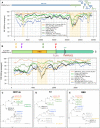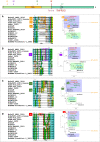Tracing the origins of SARS-COV-2 in coronavirus phylogenies: a review
- PMID: 33558807
- PMCID: PMC7859469
- DOI: 10.1007/s10311-020-01151-1
Tracing the origins of SARS-COV-2 in coronavirus phylogenies: a review
Abstract
SARS-CoV-2 is a new human coronavirus (CoV), which emerged in China in late 2019 and is responsible for the global COVID-19 pandemic that caused more than 97 million infections and 2 million deaths in 12 months. Understanding the origin of this virus is an important issue, and it is necessary to determine the mechanisms of viral dissemination in order to contain future epidemics. Based on phylogenetic inferences, sequence analysis and structure-function relationships of coronavirus proteins, informed by the knowledge currently available on the virus, we discuss the different scenarios on the origin-natural or synthetic-of the virus. The data currently available are not sufficient to firmly assert whether SARS-CoV2 results from a zoonotic emergence or from an accidental escape of a laboratory strain. This question needs to be solved because it has important consequences on the risk/benefit balance of our interactions with ecosystems, on intensive breeding of wild and domestic animals, on some laboratory practices and on scientific policy and biosafety regulations. Regardless of COVID-19 origin, studying the evolution of the molecular mechanisms involved in the emergence of pandemic viruses is essential to develop therapeutic and vaccine strategies and to prevent future zoonoses. This article is a translation and update of a French article published in Médecine/Sciences, August/September 2020 (10.1051/medsci/2020123).
Supplementary information: The online version of this article (10.1007/s10311-020-01151-1) contains supplementary material, which is available to authorized users.
Keywords: Bioinformatics; Biosafety; Coronavirus; Covid-19; Furin; Gain of function; Genome analysis; Pandemic; Phylogeny; SARS-CoV-2; Spike protein; Virology; Zoonosis.
© The Author(s) 2021.
Figures






Similar articles
-
[Tracing the origins of SARS-COV-2 in coronavirus phylogenies].Med Sci (Paris). 2020 Aug-Sep;36(8-9):783-796. doi: 10.1051/medsci/2020123. Epub 2020 Aug 10. Med Sci (Paris). 2020. PMID: 32773024 French.
-
SARS-CoV-2: Zoonotic origin of pandemic coronavirus.Acta Virol. 2020;64(3):281-287. doi: 10.4149/av_2020_302. Acta Virol. 2020. PMID: 32985202
-
The British variant of the new coronavirus-19 (Sars-Cov-2) should not create a vaccine problem.J Biol Regul Homeost Agents. 2021 Jan-Feb;35(1):1-4. doi: 10.23812/21-3-E. J Biol Regul Homeost Agents. 2021. PMID: 33377359
-
[Source of the COVID-19 pandemic: ecology and genetics of coronaviruses (Betacoronavirus: Coronaviridae) SARS-CoV, SARS-CoV-2 (subgenus Sarbecovirus), and MERS-CoV (subgenus Merbecovirus).].Vopr Virusol. 2020;65(2):62-70. doi: 10.36233/0507-4088-2020-65-2-62-70. Vopr Virusol. 2020. PMID: 32515561 Review. Russian.
-
Emergence, evolution, and vaccine production approaches of SARS-CoV-2 virus: Benefits of getting vaccinated and common questions.Saudi J Biol Sci. 2022 Apr;29(4):1981-1997. doi: 10.1016/j.sjbs.2021.12.020. Epub 2021 Dec 13. Saudi J Biol Sci. 2022. PMID: 34924802 Free PMC article. Review.
Cited by
-
Should we discount the laboratory origin of COVID-19?Environ Chem Lett. 2021;19(4):2743-2757. doi: 10.1007/s10311-021-01211-0. Epub 2021 Mar 25. Environ Chem Lett. 2021. PMID: 33786037 Free PMC article. No abstract available.
-
Are We Sure We Fully Understand What an Infodemic Is? A Global Perspective on Infodemiological Problems.JMIRx Med. 2022 Jul 21;3(3):e36510. doi: 10.2196/36510. eCollection 2022 Jul-Sep. JMIRx Med. 2022. PMID: 36409169 Free PMC article.
-
Tracing the origin of Severe acute respiratory syndrome coronavirus-2 (SARS-CoV-2): A systematic review and narrative synthesis.J Med Virol. 2022 Dec;94(12):5766-5779. doi: 10.1002/jmv.28060. Epub 2022 Sep 7. J Med Virol. 2022. PMID: 35945190 Free PMC article.
-
Impact of plasma Epstein-Barr virus DNA in posttreatment nasopharyngeal carcinoma patients after SARS-CoV-2 infection.Infect Agent Cancer. 2024 Mar 14;19(1):8. doi: 10.1186/s13027-024-00570-x. Infect Agent Cancer. 2024. PMID: 38486290 Free PMC article.
-
Have artificial lighting and noise pollution caused zoonosis and the COVID-19 pandemic? A review.Environ Chem Lett. 2021;19(6):4021-4030. doi: 10.1007/s10311-021-01291-y. Epub 2021 Jul 31. Environ Chem Lett. 2021. PMID: 34366755 Free PMC article. Review.
References
Publication types
LinkOut - more resources
Full Text Sources
Other Literature Sources
Miscellaneous
